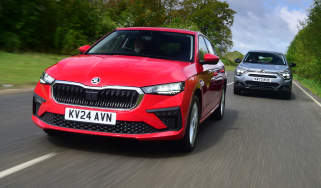New Jeep Avenger e-Hybrid 2024 review: a good small automatic SUV
The new Jeep Avenger e-Hybrid SUV combines a petrol engine with a sprinkling of electric tech
Verdict
The Jeep Avenger e-Hybrid is, in effect, an automatic version of the petrol car with a sprinkling of electric tech thrown in for good measure. We wouldn’t choose it for its powertrain alone – the differences aren’t significant enough to warrant its maker’s claims as an “access point” to electrification – but if you want a small automatic SUV, this is a good one.
The Jeep Avenger was, at launch last year, only offered as an electric car in the UK. At the time, there were no plans to add petrol power – despite the cars being confirmed for foreign buyers from day one.
But as the market matured, and retail appetite for electric cars stagnated, brand bosses were forced to reassess their strategy. Indeed, Jeep’s head of brand in Europe, Eric Laforge, openly admits how important the “freedom of choice” is to his customers, recognising some may “feel not ready yet to join this [electric] market evolution”.
As such, the Avenger is now offered with an e-Hybrid powertrain. Comprising the familiar Stellantis-sourced 1.2-litre PureTech petrol engine mated to a 28bhp electric motor and integrated into a six-speed dual-clutch automatic gearbox, the car gets a 48-volt belt starter for a “smooth transition to electric drive.” Jeep claims the 0.9kWh battery under the driver’s seat can take care of low speed manoeuvres, reducing average fuel consumption by 13 per cent.
More reviews
Car group tests
- Jeep Avenger vs Kia Niro EV vs Volkswagen ID.3: low-cost compact EVs duke it out
- Jeep Avenger vs Mazda MX-30: left-field electric SUVs face off
In-depth reviews
Long-term tests
Road tests
This e-Hybrid model sits above the base petrol, which only comes with a six-speed manual gearbox. You are therefore, in effect, paying around £1,700 extra (depending on model) for an automatic transmission, and getting the mild-hybrid technology thrown in free of charge.
Improved efficiency is the name of the game here. The added electric motor and battery add 60kg to the weight of an Avenger, so there are no tangible performance gains – in fact, the e-Hybrid is 0.3sec slower to 62mph than the pure petrol car. It gives away almost two full seconds to the EV over the same benchmark sprint.
On the road, the transition between petrol and electric is almost imperceptible – without the digital instrument cluster glowing blue, you really would be hard-pushed to tell when the engine drops in or out. It’s a quiet set-up most of the time, though the usual three-cylinder thrum makes itself known whenever you put your foot down, and there’s significant wind noise at 70mph-plus.
The gearbox is pretty slick, though. You can take control using the standard-fit steering wheel-mounted paddles, but we wouldn’t bother; it’ll happily cycle through the cogs without input from the driver, inevitably holding onto the gears a little longer in Sport mode.
Jeep says you should be able to do 20 per cent of your driving on electric power, but we managed an impressive 27 per cent (as per the trip computer) over a varied 75-mile urban, rural and motorway route. Had we had it in Eco mode the whole time, it wouldn’t have been hard to better than figure by some margin. That should, in theory, translate to a measurable boost in fuel economy, though we’d need longer with the car to quantify it.
This aside, it’s familiar Avenger fare. That means a solid but slightly unexciting driving experience; exploitation of the sorted chassis is undone somewhat by the light and lifeless steering, and while the ride is on the firm side, this isn’t a car you’d ever call uncomfortable.
There is only one level of regenerative braking, meaning it sometimes feels perfectly judged, and at others a little intrusive. On the motorway, for example, it’ll slow you more aggressively than you might like, due to the fact there’s no way to coast without sending power back to the battery. Equally frustrating is the fact it’s never strong enough to provide one-pedal driving.
The e-Hybrid line-up mirrors that of other Avengers, offered in Longitude, Altitude and Summit specifications. Base cars (from £25,300) come with 16-inch alloy wheels, full-LED lights and grey skid plates, while inside there’s fabric seats and a pair of screens – seven inches for the driver’s display and a larger 10.25-inch unit for the infotainment system. It’s packed to the gunnels with safety kit too, including autonomous emergency braking, traffic-sign recognition and lane-keep assist.
Altitude (£27,000) increases the wheel size by an inch, swaps out the grey skid plates for silver and brings ‘premium’ cloth inside. You also get climate control, adaptive cruise, and a larger 10..25-inch digital instrument cluster. Summit, like we’re driving, brings the biggest 18-inch alloys, rear LED lights and privacy glass. Interior kit is bolstered with heated front seats, wireless phone charging, a rear-view camera and an automatic tailgate, plus additional driver-assistance systems.
Quality is neither here nor there. It’s good enough in the areas you interact with on a regular basis, but scratchy plastics line the top of the doors and lower parts of the cabin. The screens are responsive enough, but the graphics par for the course in this part of the market. We do like the row of piano keys beneath the screen, which give access to the climate controls, though there’s no two-zone function and those in the back don’t even get their own vents.
The positioning of that dinky battery means space inside is unaffected, but the rear seats remain a little tight for taller adults. The 380-litre boot is identical to the petrol car’s and 25 litres larger than the EV’s; this Volkswagen Golf-matching load bay is a good size and shape, and should suit the average family’s needs.
| Model: | Jeep Avenger Summit 1.2 100HP DCT6 e-Hybrid FWD |
| Price: | £29,200 |
| Engine: | 1.2-litre 3cyl turbo petrol MHEV |
| Power/torque: | 99bhp/205Nm |
| Transmission: | Six-speed auto, front-wheel drive |
| 0-62mph: | 10.9 seconds |
| Top speed: | 114mph |
| Economy/CO2: | 57.6mpg/111g/km |
| Size (L/W/H): | 4,084/1,981/1,538mm |
| On sale: | Now |






